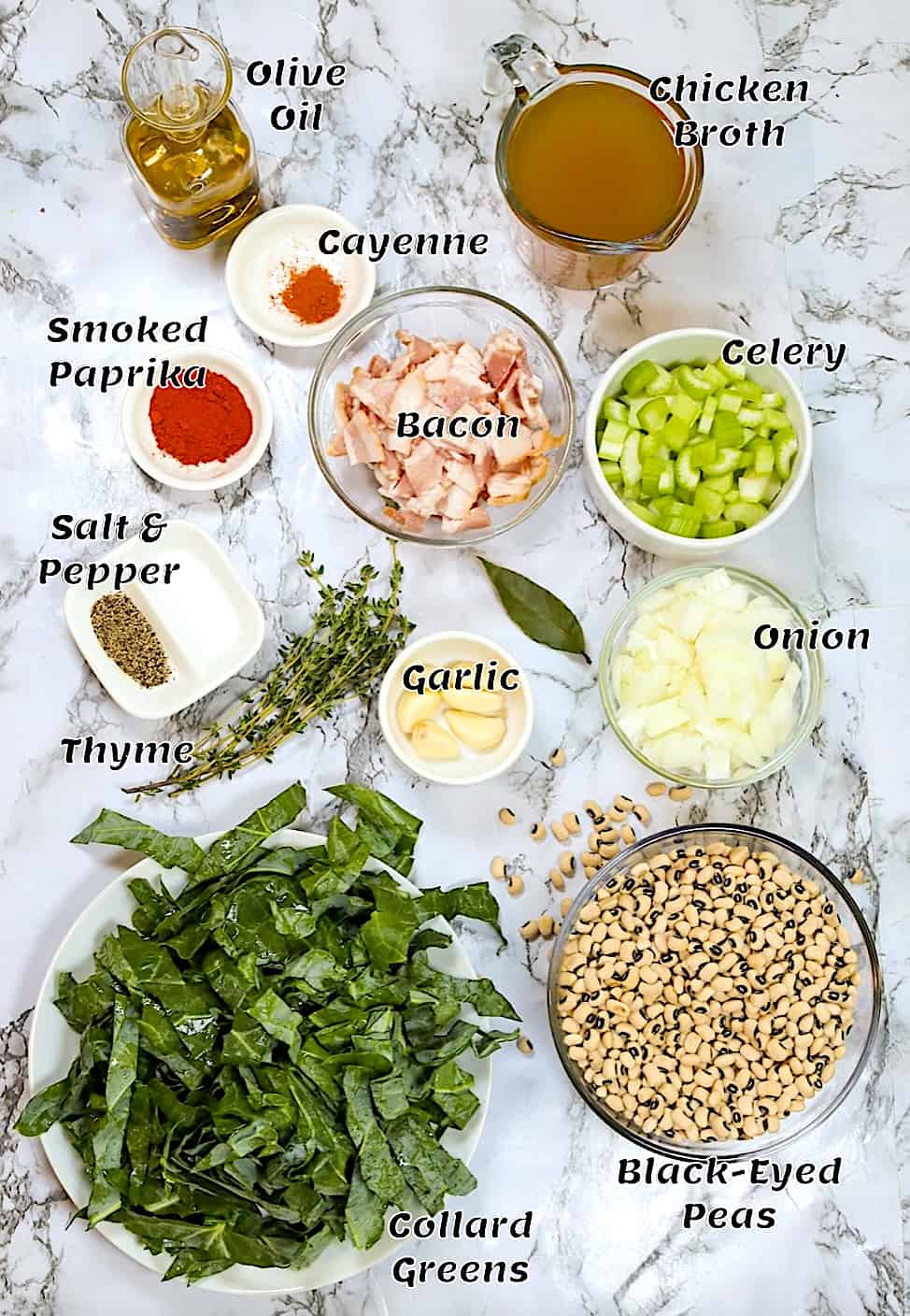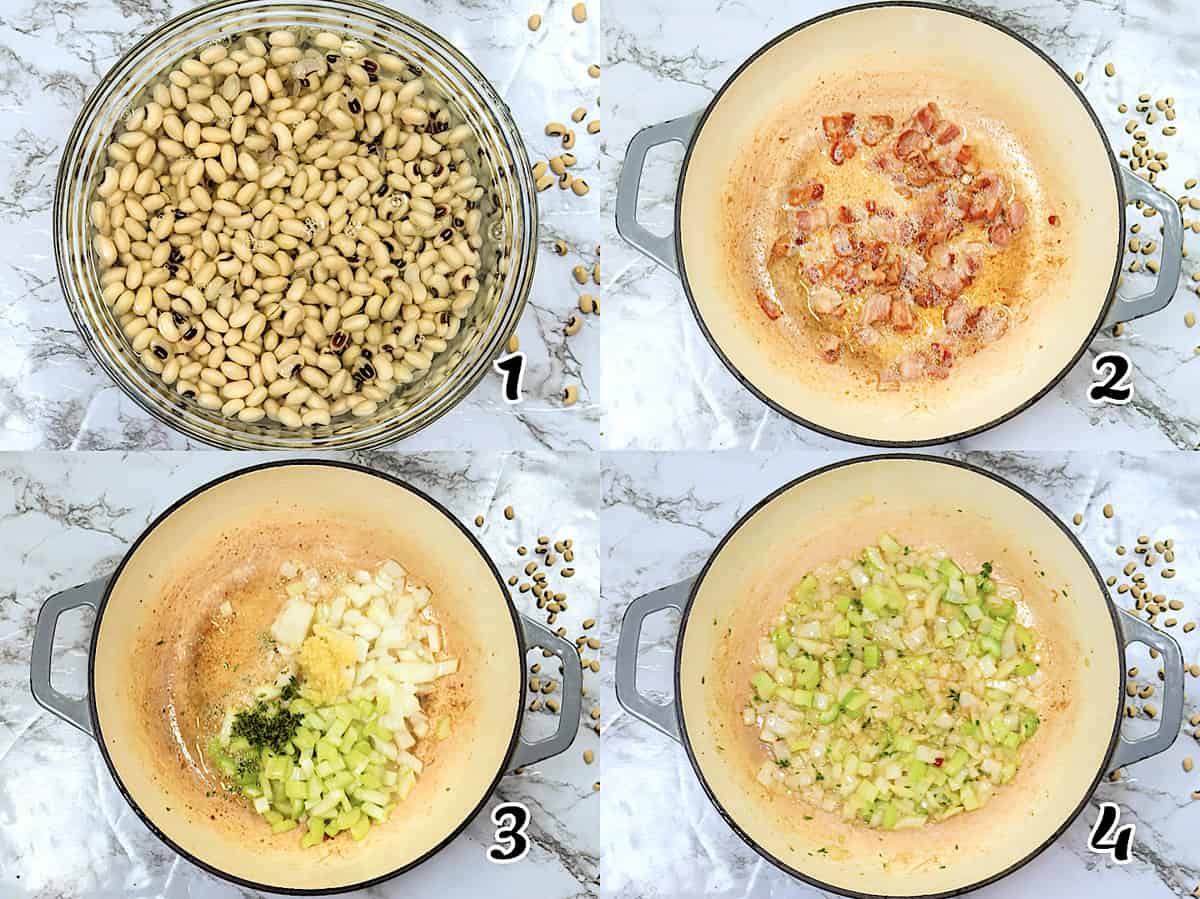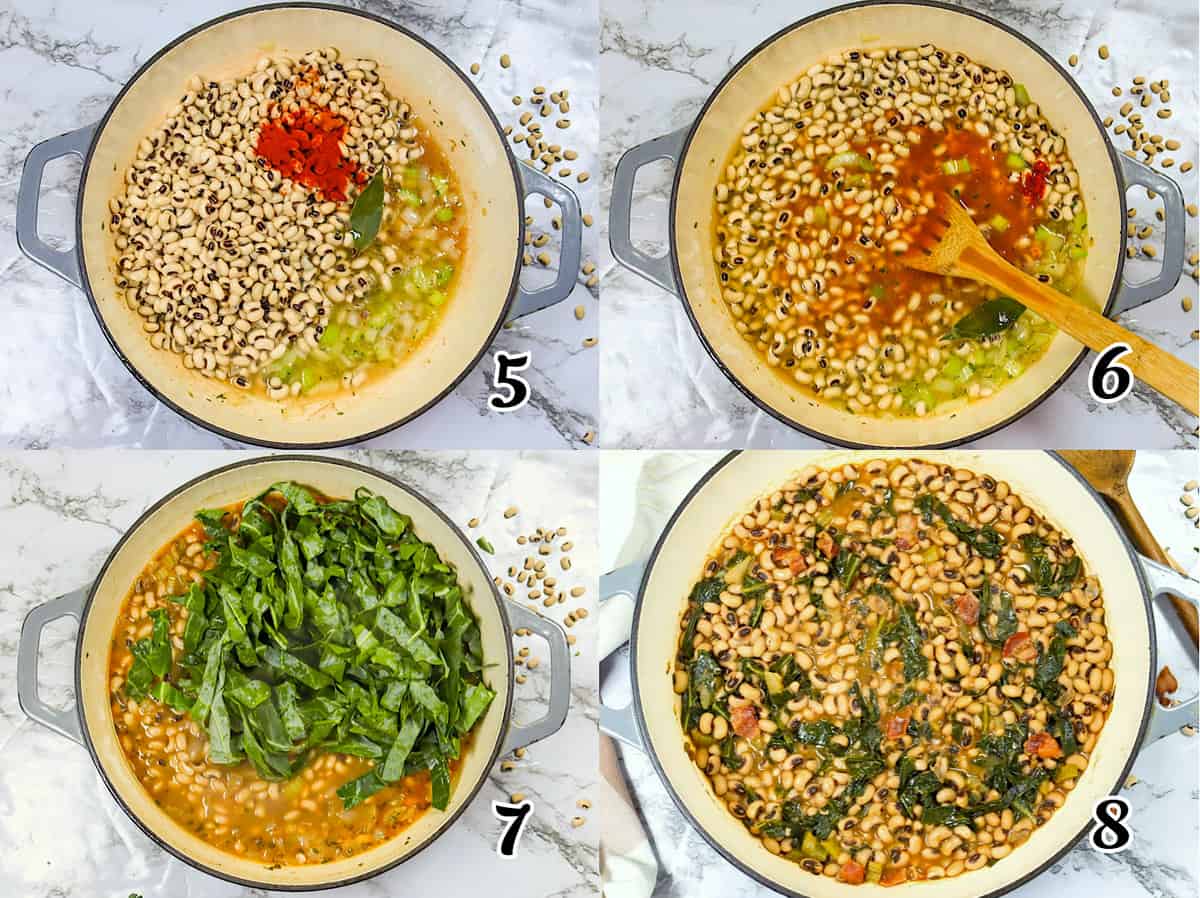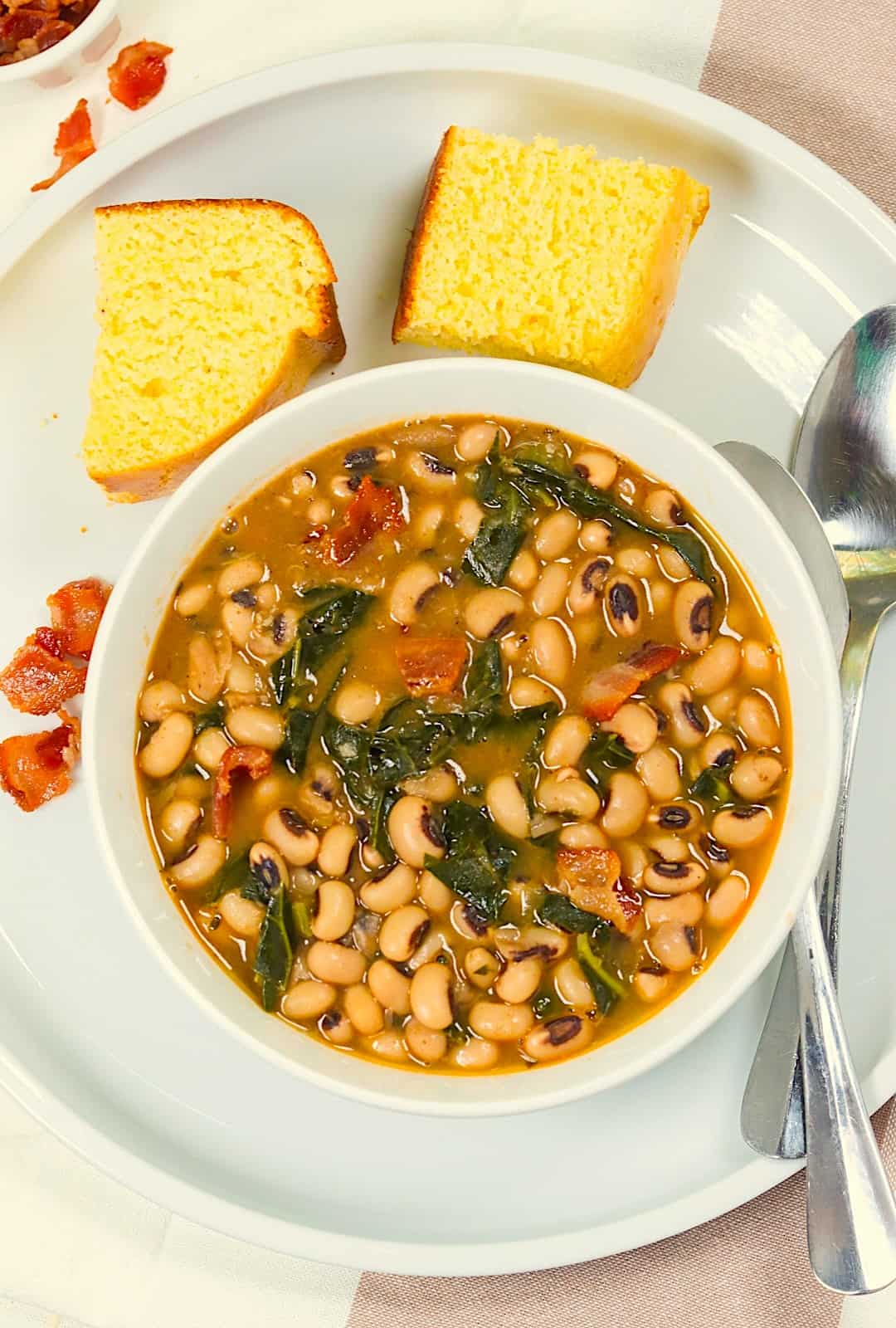Black-Eyed Peas and Collard Greens – Nothing says Southern hospitality like a soul-warming bowl of black-eyed peas and collard greens. Comfort food at its finest! 🥰

This one-pot wonder with hearty bacon, filling beans, and cooked collard leaves is incredibly delicious. There is no doubt in my mind you’ll be back for seconds.
Best of all, this meal is easy to make. It’s pretty hands-off; all it takes is a side of cornbread, and dinner is done! Did I mention it’s also truly affordable, especially if you use dry beans like I do? 😉

Black Eyed Peas, Collard Greens, and Southern Tradition
You may have noticed that black-eyed peas with collards are a really popular New Year’s Day tradition in the South. The reason is that most Southerners consider eating black-eyed peas as a way to bring good luck for themselves for the upcoming year. I don’t know if I’d call myself a believer, but I don’t mind jumping on the bandwagon occasionally. However, Let me say this dish is on my menu all year.
Recipe Ingredients

- Black Eyed Peas – I use dried black-eyed peas, but you could sub with canned in a pinch for time.
- Collard Greens – Look for fresh greens with a deep, rich color and don’t look wilty for optimal tastiness. 🥬
- Bacon – A little pork goes a long way towards extraordinarily flavorful beans and collards.
- Chicken Broth – I use chicken broth to bring everything together in a nice, warm stew, but you could use water instead.
- Veggies – Onion, garlic, and celery are the only veggies you need. They’ll add textures and loads of good flavor, too. 😋
- Seasonings – Thyme, smoked paprika, cayenne, and bay leaves are the perfect to bring the best out in our recipe for black-eyed peas and collards. Feel free to go easy on the cayenne if you don’t do spicy foods.
How to Make Black-Eyed Peas and Collard Greens

Make the Black-Eyed Peas
- Soak – The night before, place the black-eyed peas in a large bowl and fill it with cool water (there should be at least three times as much water as the peas). Allow the black-eyed peas to soak overnight in the fridge. (Photo 1)
- Cook Bacon – Heat a medium-sized skillet over medium heat. Add the bacon and fry until crisp, flipping occasionally for 5-7 minutes. Put the bacon on a paper-towel-lined plate to absorb the grease when cooked. (Photo 2)
- Cook Veggies – Drain excess bacon grease from the skillet, leaving about a tablespoon for flavor. Add the olive oil and heat on medium-low. When hot, add the onions, garlic, celery, and thyme. Sauté for 3-5 minutes until vegetables begin to soften and are fragrant. (Photos 3-4)
- Add Black-Eyed Peas – Drain the soaked peas in a colander and rinse them under cool tap water. Add the rinsed black-eyed peas to the pot with the vegetables, followed by the paprika, bay leaf, cayenne pepper (if using), and chicken broth. Mix well—season with salt and pepper to taste. (Photos 5-6)
- Simmer – Cover the pot with a lid, turn the heat to high, and bring the water to a boil. Once it boils, turn the heat down to low and simmer for 60-80 minutes.

Add the Collard Greens
- Add Greens– After one hour of simmering, the black-eyed peas should be tender. Add the collard greens and stir them in until wilted. Smash some of the peas on the side of the pot as you stir to help the liquid thicken if desired. If the soup is too thick, add a little broth or water ¼ cup at a time until it reaches your desired consistency. (Photo 7)
- Simmer – Bring the pot back to a low boil and simmer the peas and greens for an additional 15-30 minutes (depending on how tender you like your greens). It’s done when the greens are tender and the peas have broken down further, thickening the liquid more. Taste test the peas and add salt to your preference (I used about a teaspoon of salt for this recipe). (Photo 8)
- Serve – Taste the peas and add salt to your liking (I used about a teaspoon of salt for this recipe). Serve with bread, rice, or cornbread, and enjoy!

Recipe Variations
- Greens Swap: Substitute the collard greens with kale, mustard green, spinach, etc. Just be aware that some greens, like spinach, won’t need to cook as long as the collard greens.
- Meat Swap: You can use a smoked ham hock or smoked turkey instead of bacon. You can also use any combination of the three to flavor the dish.
- Vegetarian Version: Leave out the bacon and replace the chicken broth with vegetable broth for a meat-free dish.
Tips and Tricks
- Keep extra broth or water handy. If your beans get too dry during cooking, add a little broth or water ¼ cup at a time.
- How long you let the greens simmer with the peas depends on how tender you like your greens. Check on them now and again, and turn off the heat once they’re just how you like them. 👌
- Forgot to soak the peas? Don’t worry; just do a quick soak. Bring a pot of water to a boil, then stir in the dried black-eyed peas and remove them from the heat. Let them soak in the hot water for about an hour before draining and using them as per the recipe.
- Cooking time for black-eyed peas can vary, so check for doneness at around 45 minutes.
Make-Ahead Instructions
Let your black-eyed peas and collard greens cool completely, and store them in an airtight container in the fridge or freezer. They’ll keep in the refrigerator for 3-5 days or up to 3 months in the freezer.
Thaw them in the fridge the night before you plan to use them. To reheat this dish, put it in a pot on the stove over medium heat. A little chicken broth or water will loosen up the mix if it’s too thick.
Serving and Storage Instructions
Serve this dish hot off the stove with all your favorite Southern sides and meats.
Store leftovers in an airtight container in the fridge for 3-5 days, as noted above. Reheat in the microwave or on the stovetop for a quick soul-food fix.

FAQs
It’s not mandatory to soak black-eyed peas first, but it reduces cooking time and makes them more digestible (i.e., less indigestion and gas!). It’s an extra step, but definitely worth it.
Yes, both black-eyed peas and collard greens are nutritious foods. Black-eyed peas are an excellent source of fiber, protein, and various vitamins and minerals. Then, collard greens are rich in vitamins K, A, and C, as well as fiber. Bacon, on the other hand…😅
Just rinse and drain them before adding them to this recipe. Canned peas are already cooked, so you’ll need less cooking time. Instead of simmering them for an hour, simmer for a few minutes until all the flavors meld, then add your collard greens.
What Goes With Black Eyed Peas and Collard Greens
Collard greens and black-eyed peas always go well with plenty of freshly baked cornbread, in keeping with Southern tradition. And while this is easily a meal on its own, it also makes a lovely side for other Southern main courses, such as fried chicken, fried pork chops, or smoked pulled chicken.
More Southern Specialities to Try
Conclusion
Get ready to indulge in some mind-blowing soul food black-eyed peas and collards! Be sure to let me know what you think in the comments below if you try it. I always love hearing from you. 🫶
Watch How to Make It
Black-Eyed Peas and Collard Greens
Nothing says Southern hospitality like a soul-warming bowl of black-eyed peas and collard greens. Comfort food at its finest!
Prep: 10 minutes
Cook: 2 hours
Total: 2 hours 10 minutes
African, Southern
Instructions
-
The night before, place the black-eyed peas in a large bowl and fill it with cool water (there should be at least three times as much water as dried peas). Soak them overnight in the refrigerator.
-
Heat a medium-sized skillet over medium heat. Add the bacon and cook until crisp, turning occasionally for 5-7 minutes. Transfer the bacon to a paper-towel-lined plate to absorb the grease.
-
Drain the excess bacon fat from the skillet, leaving about a tablespoon for flavor. Add the olive oil and heat on medium-low. When the oil is hot, add the onions, garlic, celery, and thyme. Sauté for 3-5 minutes until vegetables begin to soften and are fragrant.
-
Next, drain the soaked peas in a colander and rinse them under cool tap water. Add the rinsed peas to the pot with the vegetables, followed by the paprika, bay leaf, cayenne pepper (if using), and chicken broth. Mix well—season with salt and pepper to taste.
-
Cover the pot with a lid, turn the heat to high, and bring the water to a boil. Once it boils, turn the heat down to low and simmer for 60-80 minutes.
-
After one hour of simmering, the black-eyed peas should be tender. Add the collard greens to the pot and stir them in until wilted. Smash some of the peas against the side of the pot as you stir to help thicken the liquid if desired. If the soup is too thick, add a little broth or water ¼ cup at a time until it reaches your desired consistency.
-
Bring the pot back to a low boil and simmer the peas and greens for an additional 15-30 minutes (depending on how tender you like your greens). It’s done when the greens are tender, and the peas have broken down further, thickening the liquid even more.
-
Taste the peas and add salt to your liking (I used about a teaspoon of salt for this recipe). Serve with bread, rice, or cornbread, and enjoy!
Tips & Notes:
- You can use smoked ham hock or smoked turkey in place of bacon or use both if desired. Leave out for a vegetarian option.
- Keep extra broth or water handy. If your beans get too dry during cooking, add a little broth or water ¼ cup at a time.
- How long you let the greens simmer with the peas depends on how tender you like your greens. Check on them now and again, and turn off the heat once they’re just how you like them.
- Forgot to soak the peas? Don’t worry; just do a quick soak. Bring a pot of water to a boil, then stir in the dried black-eyed peas and remove them from the heat. Let them soak in the hot water for about an hour before draining and using them as per the recipe.
- Cooking time for black-eyed peas can vary, so check for doneness at around 45 minutes.
- Please remember that the nutritional information is a rough estimate and can vary significantly based on the products used in the recipe.
Nutrition Information:
Serving: 1cup| Calories: 521kcal (26%)| Carbohydrates: 77g (26%)| Protein: 34g (68%)| Fat: 11g (17%)| Saturated Fat: 3g (19%)| Polyunsaturated Fat: 2g| Monounsaturated Fat: 5g| Trans Fat: 0.01g| Cholesterol: 7mg (2%)| Sodium: 169mg (7%)| Potassium: 1632mg (47%)| Fiber: 14g (58%)| Sugar: 10g (11%)| Vitamin A: 2261IU (45%)| Vitamin C: 19mg (23%)| Calcium: 237mg (24%)| Iron: 10mg (56%)
Reader Interactions










